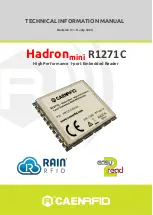
NI USB-9211/9211A User Guide and Specifications
18
ni.com
Figure 14.
Type R and S Errors
Cold-Junction Temperature Measurement Accuracy
Heat from other nearby heat sources can cause errors in thermocouple
measurements by heating up the terminals so that they are at a different
temperature than the cold-junction compensation sensor used to measure
the cold junction. The thermal gradient generated across the terminals can
cause the terminals of different channels to be at different temperatures, so
the resulting measurement creates errors not only in absolute accuracy but
also in the relative accuracy between channels.
Minimizing Thermal Gradients
Thermocouple wire can be a significant source of thermal gradients if it
conducts heat or cold directly to terminal junctions. To minimize these
errors, follow these guidelines:
•
Use small-gauge thermocouple wire. Smaller wire transfers less heat
to or from the measuring junction.
•
Run thermocouple wiring together near the screw-terminal connector
to keep the wires at the same temperature.
•
Avoid running thermocouple wires near hot or cold objects.
•
If you connect any extension wires to thermocouple wires, use wires
made of the same conductive material.
–200
0
200
400
600
800
1000
1200
0
2
4
6
Error (
°
C)
1400
1600
Measured Temperature (
°
C)
Max over Temp Range with Autozero
Max at Room Temp Range without Autozero
Typ over Temp Range with Autozero







































